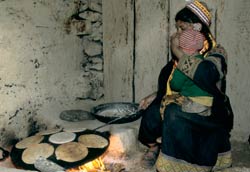Cookstove workshop targets research gaps, priorities
May / June 2011 | Volume 10, Issue 3
A large majority of the world’s households use solid fuel for cooking. Inefficient cookstoves and the air pollution they produce have been linked to low birth weight, pneumonia, lung cancer, blindness and cataracts, cardiovascular disease and other chronic ailments. What is less known is that women and girls who search for fuel risk violence and death from human predators.

Photo by Curt Carnemark/World Bank
The workshop recommendations will guide
the research priorities to be announced by
the Global Alliance for Clean Cookstoves.
A two-day workshop organized by NIH, entitled "Health Burden of Indoor Air Pollution on Women and Children in Developing Countries," brought together research and policy experts to hammer out research priorities to reduce the health risks of cookstoves to women and children. Merely building a better cookstove is not sufficient; real progress must account for available fuels, the cooking needs of the families and ease of repair so that the device is used and not stuffed with flowers and placed outside the dwelling.
"This is the NIH contribution to the larger Global Alliance," explained Dr. John Balbus of the National Institute of Environmental Health Sciences (NIEHS). Balbus, along with National Institute for Child Health and Human Development (NICHD) Associate Director Dr. William Martin and Dr. Yvonne Njage of the Fogarty International Center, organized the workshop. "And what we’re trying to do here is tee up the most critical research questions that we really have to answer in the short term, that we really have to invest the funds in now in order to ensure the success of the larger Alliance."
Cookstove-related deaths are estimated at two million annually - twice as many as from malaria. WHO lists indoor air pollution (IAP) from primitive household cooking fires in developing countries as the fourth leading cause of morbidity and mortality. Typically, the poor use biomass (wood, crop residues or dung) or coal as fuel to cook and heat their homes resulting in high levels of pollution. Women and children are primarily affected, as IAP is a major risk factor for development of acute pneumonia in children under five and, in adult non-smoking women, a cause of diseases as varied as blindness from cataracts to chronic obstructive pulmonary disease to lung and laryngeal cancer.

Photo by Michael Spencer
Pilar Nores de Garcia,
the first lady of Peru,
addressed the
conference.
Although there have been decades of efforts to use improved stove technology to reduce IAP, the success of these efforts has been limited due to a lack of awareness of the problem, limited research into the health risks and the logistical challenges of solving a problem that affects almost three billion people.
Enter the Global Alliance for Clean Cookstoves, led by the U.N. Foundation, a public-private partnership, whose mission is to save lives, improve livelihoods, empower women and combat climate change by creating a thriving global market for clean and efficient cookstoves in the developing world.
The goal is to replace 100 million cookstoves by 2020 as a way of significantly improving health among the poor. "You can’t change your genes, but you can change the environment," said NIEHS Director Dr. Linda S. Birnbaum. The Alliance hopes to raise about $250 million, with the State Department coordinating the U.S. government’s participation.
NIH led the workshop to present the state of the science on the health impacts of IAP and to determine critical research gaps that, if addressed, will foster effective strategies to reduce the impact of IAP and improve health for impoverished women and children. Funding for the workshop was provided by NIH, the State Department and the Environmental Protection Administration.
The workshop outcomes will feed into the recommendations of the Health Working Group, one of nine such groups that will contribute to a list of research priorities to be announced by the Global Alliance in early summer. Nine white papers on research topics ranging from cancer to women’s empowerment will be released in the coming months.
More Information
To view Adobe PDF files,
download current, free accessible plug-ins from Adobe's website.
Related Global Health Research Topics